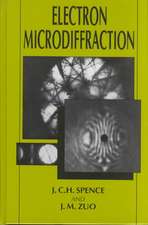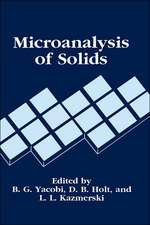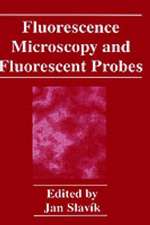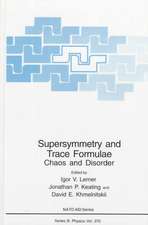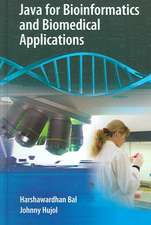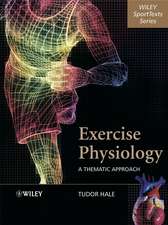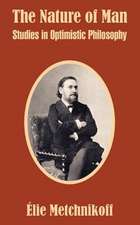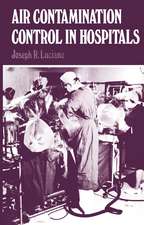Biological Electron Microscopy: Theory, Techniques, and Troubleshooting
Autor Michael J. Dykstra, Laura E. Reussen Limba Engleză Paperback – 20 noi 2012
| Toate formatele și edițiile | Preț | Express |
|---|---|---|
| Paperback (1) | 748.52 lei 6-8 săpt. | |
| Springer Us – 20 noi 2012 | 748.52 lei 6-8 săpt. | |
| Hardback (1) | 753.99 lei 6-8 săpt. | |
| Springer Us – 31 dec 2003 | 753.99 lei 6-8 săpt. |
Preț: 748.52 lei
Preț vechi: 912.84 lei
-18% Nou
Puncte Express: 1123
Preț estimativ în valută:
143.25€ • 147.98$ • 119.22£
143.25€ • 147.98$ • 119.22£
Carte tipărită la comandă
Livrare economică 25 martie-08 aprilie
Preluare comenzi: 021 569.72.76
Specificații
ISBN-13: 9781461348566
ISBN-10: 1461348560
Pagini: 556
Ilustrații: XVIII, 534 p.
Dimensiuni: 178 x 254 x 35 mm
Greutate: 1.05 kg
Ediția:2nd ed. 2003. Softcover reprint of the original 2nd ed. 2003
Editura: Springer Us
Colecția Springer
Locul publicării:New York, NY, United States
ISBN-10: 1461348560
Pagini: 556
Ilustrații: XVIII, 534 p.
Dimensiuni: 178 x 254 x 35 mm
Greutate: 1.05 kg
Ediția:2nd ed. 2003. Softcover reprint of the original 2nd ed. 2003
Editura: Springer Us
Colecția Springer
Locul publicării:New York, NY, United States
Public țintă
ResearchCuprins
1 Specimen Preparation for Electron Microscopy.- 1 Techniques.- 2 Cryotechniques.- 2 Techniques.- 3 Ultramicrotomy.- 3 Techniques.- 4.- 4 Techniques.- 5.- 5 Techniques.- 6.- 6 Techniques.- 7 Support Films.- 7 Techniques.- 8 Replicas, Shadowing, and Negative Staining.- 8 Techniques.- 9 Transmission Electron Microscopy.- 10 Vacuum Systems.- 11 High-Voltage Transmission Electron Microscopes (HVEM).- 12 Intermediate Voltage Electron Microscopes (IVEM), Electron Tomography, and Single-Particle Electron Microscopy.- 13 Scanning Electron Microscopy.- 13 Techniques.- 14.- 15 Photography.- 15 Techniques.- 16 Digital Imaging and Telemedicine.- 17 Morphometry and Stereology.- 18 Photomicroscopy.- 18 Techniques.- 19 Laboratory Safety.- 20 General Sources for Information Concerning Microscopy.- 21.- Appendix A Computing Micrometer Bar Sizes.- Appendix B Calibrating the TEM and the SEM.- I. Transmission Electron Microscope.- II. Scanning Electron Microscope.- Appendix C Materials and Methods Write-Up Suggestions for Standard TEM and SEM Preparations.- I. Materials and Methods for Routine TEM Preparation.- II. Materials and Methods for Routine SEM Preparation.
Recenzii
"In this second edition of his 1992 hardcover text and 1993 spiral-bound lab manual on Biological Electron Microscopy, Michael Dykstra has expended considerable effort to merge the two earlier volumes into a more readable and usable single volume and also to update them and add considerable new material. Happily, the result is a first rate, comprehensive book that will be useful for both teaching beginning students and as a reference book for experienced researchers.
In all chapters, new materials have been added in the text and referenced at the chapter ends, and where appropriate, useful web sites have been indicated where additional information may be obtained. All of the excellent illustrative photographs from the first edition have been retained. As before, the chapters on microscope construction and operation are very well done and will be invaluable in teaching. Cautionary statements are made throughout about handling and disposal of the hazardous materials used in EM labs. Relevant journals, societies, and equipment suppliers are listed in appendices.
In general, this single volume is a welcome addition to the literature available on biological microscopy. Its publication offers support for the idea that microscopy in all of its guises is still a dynamic and valuable tool for all biologists."
(Henry C. Aldrich, Professor Emeritus of Microbiology and Cell Science, University of Florida, Gainesville)
In all chapters, new materials have been added in the text and referenced at the chapter ends, and where appropriate, useful web sites have been indicated where additional information may be obtained. All of the excellent illustrative photographs from the first edition have been retained. As before, the chapters on microscope construction and operation are very well done and will be invaluable in teaching. Cautionary statements are made throughout about handling and disposal of the hazardous materials used in EM labs. Relevant journals, societies, and equipment suppliers are listed in appendices.
In general, this single volume is a welcome addition to the literature available on biological microscopy. Its publication offers support for the idea that microscopy in all of its guises is still a dynamic and valuable tool for all biologists."
(Henry C. Aldrich, Professor Emeritus of Microbiology and Cell Science, University of Florida, Gainesville)
Caracteristici
Covers a wide range of topics including conventional light microscopy, transmission electron microscopy, and scanning electron microscopy Includes a survey of each subject, and a techniques section, where appropriate, with tried-and-true methods that will produce publishable results Serves as a broadly applicable starting point for a variety of approaches to cytological research



